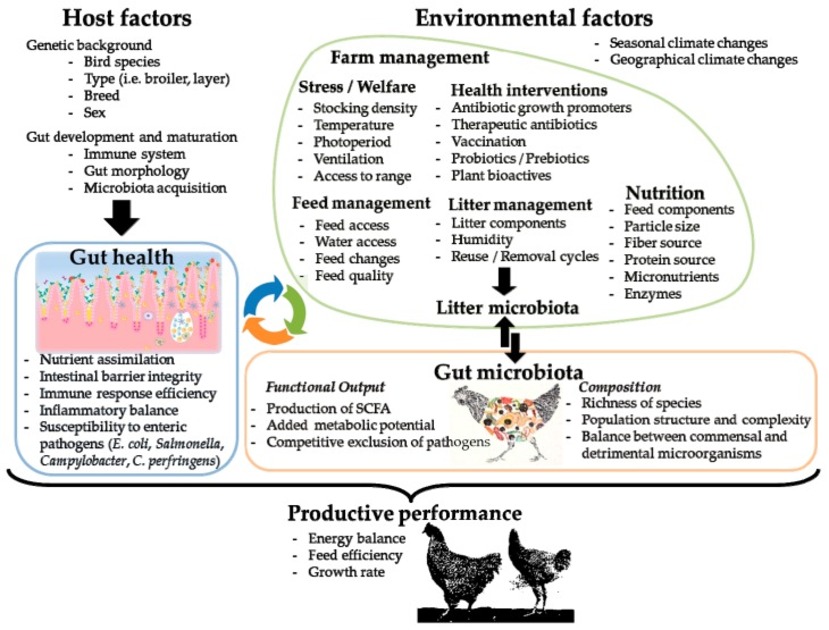Table of Contents
The article introduces the microbial phase as a tiny group of organisms in the ecosystem, these microorganisms play an important role in the intestinal tract of animals, and the microbial phase can be closely related to the intestinal health and productivity of chickens.
Factors affecting the intestinal flora of chickens:
Intestinal flora is closely related to many physiological functions, such as nutrient regulation, metabolism and immunity, among which digestion is inseparable from flora, such as nutrient absorption, feed conversion rate, energy conversion and productivity. The intestinal tract of chickens contains four main bacterial phyla, such as Bacillota, Bacteroidota, Proteobacteria, and Actinomycetota, and different sections of the intestinal tract also have different advantageous bacterial clusters.
Poultry start laying intestinal flora from the beginning of hatching. Since microorganisms can enter through the pores of the egg shell, the artificial incubation environment nowadays avoids the colonization of pathogenic bacteria as much as possible. It has been reported in the literature that colonizing bacteria are inherited from the mother hen, so it is very important to cultivate the intestinal flora in the hen. Some professionals are also evaluating the possibility of inoculating prebiotics, probiotics or microorganisms directly on or in the eggs to establish a good flora ecology at the early stage of growth.
The management of chickens is one of the most important aspects of commercializing chickens, and the season and climate are also very important in this regard. How to control the temperature and humidity is a great challenge for farmers. Argentinean academics have found in farms that the abundance of microorganisms in the cecum varies according to the season, for example, in summer the abundance is twice as high as in winter. Then there is the farm environment, where hygiene and biosecurity, feed quality and processing, vaccination, drug use, stocking density, light cycle, ventilation, ammonia concentration and stress are all factors related to the environmental microflora. Excreta is a part of the environment and is related to the substrate of the bedding. Chickens are constantly ingesting bedding particles as they grow, so the intestinal flora is also affected by this. It has been found in one study that an increase in the abundance of microflora produced by bedding increases the productivity of chickens during the winter months.
Microbiota in relation to intestinal health and immunity
There is no clear definition of intestinal health. Phenotypic integrity, intestinal function, metabolism, energy balance and immune response are all factors that affect intestinal health. In the process of development, the intestinal flora and the immune system are inextricably linked. Microorganisms inhibit the growth of pathogens so that they are unable to produce toxic metabolites and produce complex polysaccharides for the host, which increase the host’s ability to resist them. One study has shown that the interaction between the gut microbial phase and the innate immune system affects the acquired immune response, which in turn affects the activity of B cells and T cells. β-Defensins are antimicrobial peptides found on the surface of the intestinal epithelium which form an important part of innate immunity. These peptides are produced in response to lipopolysaccharide stimulation and involve the Toll-like receptor (TLR-4) and the transcription factor NF-κB. β-Defensin levels are influenced by microorganisms, and a reduction in microorganisms leads to reduced β-defensin expression in the duodenum and cecum of pre-growing avian species. The composition of the intestinal microbial community by the host’s innate immune system can shape the acquired immune response, which can be either B-cell or T-cell activity. In addition, the microbial community helps to eliminate pathogens, ferment a variety of substrates, and provide energy to the host.
The use of oral antibiotics to alter the gut microbiota of chickens during the early stages of growth has been associated with subsequent immune dysfunction, including conditions of autoimmune disease. When antibiotics are introduced into the animal diet, the host intestinal inflammatory response as well as the structure and diversity of the intestinal microbial community are also altered. Low concentrations of antibiotics have been commonly used as growth promoters in the poultry industry around the world, where broiler chickens are fed a standard diet supplemented with antibiotic growth promoters, virginiamycin, or bacitracin methylene disalicylate, and the results showed that antibiotic supplementation has a profound effect on the levels of a wide range of chemical compounds. The poultry fed bacitracin methylene disalicylate had similar microbial diversity and species abundance as the control group, but the composition of the cecum and ileum bacterial communities differed. It was noted in a report that microflora infected with Salmonella showed increased expression of IL-6 cytokines in the cecal tonsils, ileum, and spleen.
Microorganisms and Productivity
Poultry productivity can be evaluated by measuring different parameters including feed conversion ratio (FCR), residual feed intake (RFI), breast weight gain (BWG) and time to market body weight. The relationship between the species diversity of the gut microbiota and the efficiency of poultry rearing has not been confirmed by studies. In cattle, a less diverse rumen microbiota was found in more efficient animals, which the authors hypothesized to be related to the microbiota’s specialization in the production of metabolites, mainly fatty acids that short-chain volatile substances can be used as energy and carbon sources for animal growth. However, studies have found higher bacterial diversity in the intestines of poultry with lower feed conversion rates or higher feed efficiencies. In another study, the detection of different bacterial groups in the ileum was associated with chicken productivity. Contrary to expectations, two studies showed that the presence of Enterobacteriaceae was associated with higher productivity, while the presence of Lactobacillus was associated with lower productivity.
Conclusion
Maintaining a good micro-ecological balance is the key to improving chicken productivity. Further research will be conducted to better understand the specific effects of different micro-ecological groups on chickens and to develop more effective micro-ecological management strategies.
References: MDPI Journal

